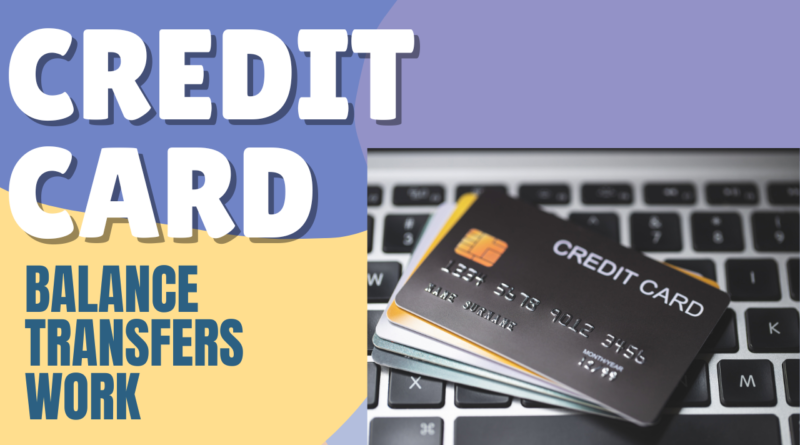How do Credit card balance transfers work?
Credit card balance transfers can be a powerful tool for managing and reducing debt, but they also come with their own set of complexities and potential pitfalls. Understanding How do credit card balance transfers work, the benefits they offer, and the risks involved is crucial for anyone considering this financial strategy. This detailed guide will walk you through the ins and outs of credit card balance transfers, providing the knowledge you need to make informed decisions.
What Is a Credit Card Balance Transfer?
A credit card balance transfer involves moving the outstanding balance from one or more credit cards to another credit card, typically one that offers a lower interest rate or even a 0% introductory APR (Annual Percentage Rate) for a specific period. The primary goal is to save money on interest, making it easier and faster to pay off the debt.
Balance transfers can be especially beneficial for individuals carrying high-interest debt, as they allow you to consolidate your debt into a single, more manageable payment with a lower interest rate.
How to Do a Credit Card Balance Transfer the Right Way
A credit card balance transfer can be a smart financial move if done correctly. It can help you save money on interest, pay down debt faster, and consolidate multiple payments into one. However, to maximize these benefits and avoid common pitfalls, you need to approach the process with a clear strategy. Here’s how to do a credit card balance transfer the right way.
1. Evaluate Your Current Debt Situation
Before you consider a balance transfer, take stock of your current financial situation. List all your credit card debts, including the outstanding balances, interest rates, and minimum monthly payments. This will help you determine if a balance transfer is the best option for you and how much you could potentially save.
2. Research Balance Transfer Offers
Not all balance transfer credit cards are created equal. Some may offer 0% APR for an introductory period, while others might have a lower promotional rate or different fees. Look for a card that offers a long introductory period with 0% or low-interest APR and has minimal fees. Consider the following factors:
- Introductory APR and Duration: A 0% APR for 12-18 months is ideal. The longer the promotional period, the more time you have to pay off the balance without incurring interest.
- Balance Transfer Fee: Most cards charge a balance transfer fee, typically 3-5% of the amount transferred. Calculate whether the interest savings outweigh the fee.
- Standard APR: Check the APR that will apply after the introductory period ends. If you can’t pay off the balance within the promotional period, you want to avoid high-interest rates.
3. Apply for the Balance Transfer Card
Once you’ve found the right card, apply for it. Keep in mind that your credit score and credit history will influence whether you’re approved and what credit limit you’ll receive. A higher credit score typically results in better offers.
When applying, only request the amount you need to transfer. Remember that your credit utilization ratio (the amount of credit you’re using relative to your total available credit) impacts your credit score, so transferring a large balance could affect your score.
4. Initiate the Balance Transfer
After your application is approved and you receive your new card, you can initiate the balance transfer. This process varies by issuer, but it generally involves:
- Providing details of the debt you want to transfer (account numbers and amounts).
- Specifying how much of the balance you want to transfer (some issuers allow partial transfers).
- Confirming the transfer with your new card issuer.
The transfer can take anywhere from a few days to a few weeks to complete. During this time, continue making payments on your old credit card accounts to avoid late fees or penalties.
5. Create a Repayment Plan
The key to making the most of a balance transfer is to pay off the debt before the introductory period ends. To do this, calculate how much you need to pay each month to eliminate the balance within the promotional period.
For example, if you transferred $5,000 and have a 0% APR for 15 months, you’d need to pay approximately $334 per month to clear the debt before interest kicks in. Stick to this plan and avoid making only the minimum payments, as this will not help you eliminate the debt efficiently.
6. Avoid New Purchases on the Balance Transfer Card
It’s important not to use the new balance transfer card for additional purchases, especially if the 0% APR doesn’t apply to new purchases. New charges will accrue interest immediately, which can derail your repayment plan. If you must use the card, ensure you have a separate strategy for paying off those new charges quickly.
7. Keep Your Old Credit Cards Open
After transferring the balance, resist the urge to close your old credit card accounts, unless there’s an annual fee you want to avoid. Keeping these accounts open can help maintain your credit score by keeping your credit utilization ratio low. However, avoid using these cards to prevent falling into more debt.
8. Monitor Your Progress
Regularly check your account statements and your credit report to ensure everything is on track. Verify that the balance transfer has been correctly applied and that your payments are being processed as planned. Monitoring your credit score during this period can also help you stay aware of any changes.
9. Be Mindful of the End of the Introductory Period
As the end of the introductory period approaches, make sure you’re prepared for the transition to the regular APR. If you haven’t paid off the balance by this time, consider your options:
- Pay Off the Remaining Balance: If possible, make a lump-sum payment to avoid paying interest.
- Negotiate a Lower APR: Contact your card issuer to see if they can offer a lower interest rate moving forward.
- Transfer the Balance Again: If you qualify for another balance transfer offer, you might consider moving the remaining balance to a new card with another promotional rate.
10. Learn from the Experience
A balance transfer is a temporary solution that can help you pay off debt, but it’s not a cure-all. Use this experience as an opportunity to reassess your spending habits and financial management strategies. Consider creating a budget, building an emergency fund, and reducing reliance on credit to prevent falling back into debt.
How Do Credit card balance transfers work?
- Finding the Right Balance Transfer Card
The first step in a balance transfer is selecting the right credit card. Many credit card issuers offer special balance transfer promotions, such as a 0% APR for 12-18 months. It’s essential to compare different cards to find the one that best suits your needs, considering factors such as the length of the introductory period, the standard APR after the introductory period ends, and any fees associated with the transfer. - Application Process
Once you’ve chosen a card, you’ll need to apply for it. If you’re approved, the credit card issuer will typically provide you with a balance transfer offer. This offer will outline the terms, including the duration of the introductory APR and any applicable balance transfer fees. - Initiating the Transfer
After receiving the card and offer, you can initiate the transfer. This can usually be done online, by phone, or by mail. You’ll need to provide details of the debt you want to transfer, including the account numbers and the amounts. The new card issuer will then pay off your old credit card(s) directly and transfer the balance to your new card. - Paying Off the Balance
Once the transfer is complete, your old credit card balances will be reduced to zero, and you’ll owe the transferred amount on your new card. You’ll then need to start making payments to the new card issuer. During the introductory period, it’s crucial to pay down as much of the balance as possible since the low or 0% interest rate will eventually expire. - End of Introductory Period
After the introductory period ends, the interest rate will revert to the card’s standard APR, which is often much higher. If you haven’t paid off the balance by then, the remaining amount will accrue interest at this higher rate. It’s essential to understand this and plan your payments accordingly.
Benefits of Credit Card Balance Transfers
- Interest Savings
The most significant benefit of a balance transfer is the potential to save on interest. By transferring high-interest debt to a card with a lower or 0% introductory rate, you can significantly reduce the amount of money you pay in interest, freeing up more funds to pay down the principal balance. - Debt Consolidation
Balance transfers also allow you to consolidate multiple credit card debts into one account. This simplifies your financial management by reducing the number of payments you need to make each month, potentially lowering your overall monthly payment. - Accelerated Debt Repayment
With lower or no interest accruing during the introductory period, more of your payments go toward reducing the principal balance. This can help you pay off your debt faster, assuming you continue to make regular, substantial payments. - Improved Credit Score
If you manage your balance transfer effectively, it can positively impact your credit score. By paying down your debt more quickly and maintaining a lower credit utilization ratio (the amount of credit you’re using relative to your total credit limit), your credit score may improve over time.
Expert Tip: Beware of Interest Rates
When considering a credit card balance transfer, it’s crucial to be vigilant about interest rates. The introductory 0% APR offer may seem attractive, but it’s temporary. Once the promotional period ends, the interest rate can skyrocket, sometimes reaching 20% or more. If you haven’t paid off your balance by then, you could end up paying more in interest than you saved.
To avoid this, create a repayment plan to eliminate your balance before the higher interest rate kicks in. Always read the fine print and understand what the standard APR will be after the introductory period. Being aware of these details will help you make a more informed decision and avoid unexpected costs.
Potential Risks and Downsides
- Balance Transfer Fees
Most balance transfer credit cards charge a fee for the service, typically around 3-5% of the amount transferred. While this fee might be worth paying if you can save significantly on interest, it’s important to factor it into your overall cost-benefit analysis. - High Post-Introductory APR
Once the introductory period ends, the card’s regular interest rate will apply, which can be much higher than the rate on your original credit cards. If you haven’t paid off the balance by this time, you could end up paying more in interest than you initially anticipated. - Impact on Credit Score
Applying for a new credit card will result in a hard inquiry on your credit report, which can temporarily lower your credit score. Additionally, transferring a large balance to a new card could increase your credit utilization ratio, potentially leading to a dip in your score. - Temptation to Accumulate More Debt
A balance transfer can free up credit on your old cards, which might tempt you to start using them again. This could lead to accumulating even more debt, defeating the purpose of the transfer in the first place. - Complex Terms and Conditions
Credit card balance transfers often come with specific terms and conditions that can be confusing. For example, the 0% APR might only apply to the transferred balance and not to new purchases, or missing a payment could result in losing the promotional rate. It’s crucial to read the fine print and understand all the terms before committing to a balance transfer.
How to Maximize the Benefits of a Balance Transfer
- Plan Your Payments
To maximize the benefits of a balance transfer, create a repayment plan that ensures you pay off the balance before the introductory period ends. Calculate how much you need to pay each month to achieve this goal and stick to it. - Avoid New Purchases on the Balance Transfer Card
Using the balance transfer card for new purchases can complicate your repayment strategy. Unless the card offers the same 0% APR on purchases, new charges will start accruing interest immediately, making it harder to pay off the transferred balance. - Keep Old Accounts Open
Closing your old credit card accounts after transferring the balance can negatively impact your credit score by reducing your available credit and increasing your credit utilization ratio. Instead, keep these accounts open, but refrain from using them until you’ve paid down your debt. - Monitor Your Credit Score
Regularly check your credit score to see how the balance transfer is affecting it. This will help you catch any potential issues early and make adjustments to your strategy if needed. - Be Aware of Promotional Rate Conditions
Some balance transfer cards have conditions that could cause you to lose the promotional rate, such as making a late payment. Ensure you’re aware of these conditions and take steps to avoid triggering them. - Consider Alternatives
If a balance transfer doesn’t seem like the right fit for your situation, consider other debt management options, such as a personal loan, debt consolidation, or working with a credit counselor. These alternatives might offer different benefits and could be more suitable for your financial needs.
Common Mistakes to Avoid
- Failing to Pay Off the Balance
One of the most common mistakes people make is not paying off the transferred balance before the introductory period ends. This can result in paying high interest on the remaining balance, negating the benefits of the transfer. - Ignoring the Balance Transfer Fee
The fee associated with a balance transfer can be significant, especially if you’re transferring a large amount of debt. Failing to account for this cost can lead to unexpected expenses and reduce the overall savings from the transfer. - Not Reading the Fine Print
Credit card offers can be complex, with many terms and conditions that aren’t immediately apparent. Not reading the fine print can result in unpleasant surprises, such as losing the 0% APR due to a missed payment or discovering that the promotional rate doesn’t apply to new purchases. - Continuing to Use Old Credit Cards
Using your old credit cards after transferring the balance can lead to accumulating more debt, making it even harder to become debt-free. It’s important to resist the temptation to use these cards and focus on paying down your existing debt. - Overlooking the Impact on Your Credit Score
Balance transfers can impact your credit score in several ways, both positively and negatively. Not considering these impacts can lead to unintended consequences, such as a lower score that makes it harder to qualify for loans or other credit in the future.
What happens to a credit card after a balance transfer?
After a balance transfer, the original credit card you transferred the debt from remains open unless you decide to close it. The balance on that card is now zero or reduced, depending on how much was transferred. You can continue using the card for new purchases, but it’s often wise to avoid adding more debt to it. Keeping the old card open can also help maintain your credit score, as it contributes to your overall credit utilization ratio. However, if the card has a high annual fee, you might consider closing it once the transfer is complete.
Will a balance transfer hurt my credit score?
Transferring a balance to an existing credit line won’t negatively affect your credit score. However, applying for a new credit card for the transfer
might have a slight impact on your score. Ideally, balance transfers are used to reduce debt, which can actually improve your credit score by lowering your credit utilization ratio. A lower utilization ratio—how much credit you’re using compared to your available limit—is beneficial for your credit score, as this ratio accounts for 30% of your overall credit score.
ALSO READ: Save Money, Live Better: 10 Tips that act as a Blueprint for Success in Life
Alternatives to a Credit Card Balance Transfer
If a credit card balance transfer isn’t the right fit for you, there are other options to help you manage and reduce your debt. Here are some alternatives:
1. Debt Consolidation Loan
A debt consolidation loan allows you to combine multiple debts into a single loan with a fixed interest rate. This simplifies payments and can potentially lower your interest rate. Personal loans are commonly used for debt consolidation and can have terms ranging from 2 to 7 years, offering predictable monthly payments.
2. Personal Loan
A personal loan can be a good option for paying off high-interest credit card debt. These loans usually have fixed interest rates and terms, allowing you to know exactly how much you’ll pay each month and when your debt will be fully repaid. Depending on your credit score, you might secure a lower interest rate than your current credit card APR.
3. Home Equity Loan or Line of Credit (HELOC)
If you own a home, you might consider a home equity loan or a home equity line of credit (HELOC). These options allow you to borrow against the equity in your home, often at a lower interest rate than credit cards. However, they come with the risk of losing your home if you fail to repay, so they should be used cautiously.
4. Debt Management Plan (DMP)
A Debt Management Plan is offered by credit counseling agencies and can help you manage your debt more effectively. The agency negotiates with your creditors to reduce interest rates and consolidate your payments into one monthly payment. This plan typically takes 3 to 5 years to complete, and during this time, you may be required to close your credit card accounts.
5. Negotiate with Creditors
Sometimes, you can negotiate directly with your credit card issuers to lower your interest rate or arrange a more manageable payment plan. This can be a good option if you’re struggling with payments but want to avoid the impact on your credit score that comes with other solutions.
6. Pay Off Debt with a Higher Interest Rate First (Debt Avalanche)
The debt avalanche method involves paying off your debt with the highest interest rate first while making minimum payments on the others. Once the highest-interest debt is paid off, move on to the next highest. This method can save you the most money on interest over time.
7. Pay Off Smaller Debts First (Debt Snowball)
The debt snowball method focuses on paying off the smallest debts first to build momentum. Once the smallest debt is paid off, you move on to the next smallest, adding the previous payment amount to the new one. While this method might not save as much on interest, it can provide a psychological boost by quickly eliminating debts.
8. Use a 401(k) Loan
If you have a 401(k) retirement account, you might be able to borrow from it to pay off your debt. These loans typically have low-interest rates and no impact on your credit score. However, borrowing from your retirement savings can hinder your long-term financial goals and comes with penalties if you leave your job before repaying the loan.
9. Credit Counseling
Credit counseling agencies can provide advice and assistance in managing your debt. They can help you create a budget, understand your financial situation, and explore various debt repayment options, including Debt Management Plans. While these services may come with fees, they can be valuable if you need guidance on getting out of debt.
10. Bankruptcy
As a last resort, bankruptcy can discharge many types of debt. However, it comes with significant long-term consequences, including severe damage to your credit score and difficulty obtaining credit in the future. Bankruptcy should only be considered when all other options have been exhausted and under the guidance of a financial advisor or attorney.
Be cautious with balance transfers
Be cautious with balance transfers. While they can help you save on interest and pay down debt faster, they also come with potential risks. Pay close attention to the terms, including the balance transfer fee, the length of the promotional period, and the interest rate that applies after the introductory offer ends. If you don’t pay off the balance within the promotional period, you could end up with higher interest charges than before. Additionally, avoid using the new card for additional purchases, as this could lead to accumulating more debt.




